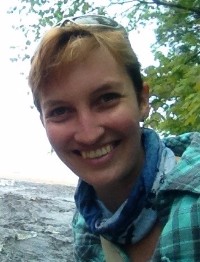
Klara Scharnagl is a PhD candidate in the Plant Biology Department at Michigan State University. She grew up in Miami, Florida. She received her Bachelor’s degree from the University of Chicago in 2010, and her Master’s degree from Florida International University in 2013. Klara’s master’s thesis is titled “The effects of arbuscular mycorrhizal fungi on four legume hosts in south Florida pine rockland soils.” Her current research is studying the role of symbiosis as a biotic interaction in driving patterns of biodiversity along a latitudinal gradient, using lichens as my study system. She is comparing a field sampling approach to an herbarium record approach using the Consortium of North American Lichen Herbaria (CNALH) and GBIF online databases to determine gradients of fungal diversity. She has visited 8-10 lowland forest sites in the Americas, and sampled epiphytic lichen diversity on 100 trees at each site. Further, she will select a sub-group of lichens from the field samples to sequence both the fungal and algal partners in order to determine (a) cryptic species diversity, (b) specificity of the fungal-algal association along a latitudinal gradient, and (c) to reconstruct phylogenies to search for latitudinal signatures in diversification events.
How did you become a mycologist?
Ever since I was six years old, on a family camping in North Carolina Smoky Mountains, I have been fascinated by fungi. But it took a lichen internship at the Field Museum in Chicago during my undergrad to decide that I would pursue mycology as a career.
Who is your mycology role model?
Anne Pringle is my role model because she is not afraid to ask and investigate the interesting questions. Her lab has done research across a broad array of fungi and have taken approaches from citizen science to physics.
What is your favorite mushroom, and what do you like about it?
Chlorociboria aeruginascens, because it reminds me of family camping trips in North Carolina, and because it makes that beautiful green-blue stain on the wood it grows on.
What is your favorite lichen, and what do you like about it?
I have many favorites. But one that I like is the fruticose soil lichen, Stereocaulon. It looks like a miniature white shrub on the ground, and many of them have the unique biology of containing both green algal and cyanobacterial symbionts. It is also intriguing to me because it has a lot of cryptic diversity and is in major need of revision. Future project, perhaps?
What is your favorite thing/fact about lichens?
Again, there are so many fascinating things about lichens. The symbiosis itself is one thing I hope to delve deeper into in my research. But one thing I think is really cool is the ability of lichens to live practically everywhere, from the tideline to the tops of mountains, from deserts to lush rainforests, from grasslands in the Western US to interior Antarctica. Interestingly, one of the few places lichens Cannot live is a really polluted city. Talk about great bioindicators!
Do you have any funny or interesting stories about field work?
I cannot tell you how many times I have picked up or even collected poop in the field, thinking that it might be some interesting type of fungus or lichen. Studying lichens means a fair bit of time standing still staring at a tree. This can give you blinders to the world around you, until your focus shifts a bit, and you realize that, in addition to the lichens, you are staring right at a lizard, a large spider, or even a tree viper! Luckily they were just as stunned by the lichenologist as the lichenologist was by them.
What do you like to do in your free time? What are your hobbies?
I love talking about lichens, running workshops on lichens, and making “Lichen Buddies” for kids. In addition to this, I love hiking, running, kayaking, baking and writing poetry. When I have the time, of course!


Leave a Reply